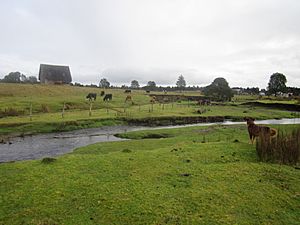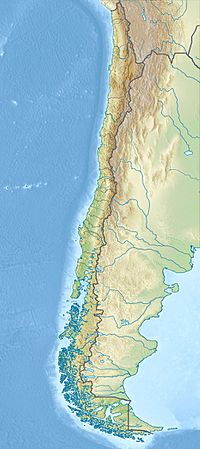Monte Verde facts for kids

View of Monte Verde and Chinchihuapi Creek in 2012
|
|
| Location | Southern Chile |
|---|---|
| Coordinates | 41°30′17″S 73°12′16″W / 41.50472°S 73.20444°W |
| Type | open-air |
Monte Verde is a very old archaeological site in southern Chile. It is located near the city of Puerto Montt. Scientists have found evidence that people lived here as early as 18,500 years ago.
This discovery is very important because it changed what many scientists thought about when the first humans arrived in the Americas. Before Monte Verde, many believed that the first people belonged to the Clovis culture, which appeared about 13,500 years ago. Monte Verde shows that people were living in the Americas much earlier, possibly 1,000 to 5,000 years before the Clovis people.
The findings at Monte Verde were first doubted by many scientists. But over time, more evidence made them accept that people lived there so long ago. This site also supports the idea that early humans might have traveled along the coast to settle the Americas.
Contents
How Monte Verde Was Found
Discovery of the Site
The Monte Verde site was found by accident in 1975. A student was visiting the area, where a lot of trees had been cut down. This logging caused the ground to wear away, or erode. Local farmers showed the student a strange "cow bone" they had found. This bone turned out to be from a gomphothere, an ancient elephant-like animal.
In 1977, Tom Dillehay, an American anthropologist and professor, began digging at Monte Verde. He quickly realized how special the site was.
Why Monte Verde Was Preserved
Monte Verde is located next to the Chinchihuapi Creek. This area was very wet and marshy. Soon after people lived there, the creek's waters rose and formed a peat bog. A bog is a type of wetland. This bog helped keep many things from decaying, like wood, plants, and even animal hides. This is why so many ancient items were found in such good condition.
In 1982, tests on bones and charcoal showed that the site was about 14,800 years old. This was more than 1,000 years older than any other known human settlement in the Americas at that time.
Life at Monte Verde
What Was Found at Monte Verde II
The main part of the site, called Monte Verde II (MV-II), shows clear signs of human life from about 14,800 to 13,800 years ago. Archaeologists believe about 20 to 30 people lived here.
They found evidence of a large, tent-like structure, about 20 feet long. It was made of wood and animal hides. Logs and planks were stuck into the ground to make walls, which were then covered with animal skins. Ropes made from local plants were used to tie the hides to the poles. Inside, there were separate living areas.
Outside this main structure, there were two large fire pits. These were probably used by the whole community for things like making tools. Inside the living areas, smaller fire pits were found. Around these, scientists discovered many stone tools and bits of seeds, nuts, and berries.
One amazing find was a 13,000-year-old wild potato. This is the oldest potato ever found! It suggests that southern Chile was an important place where potatoes first grew. Scientists also found remains of 45 different kinds of edible plants. More than a fifth of these plants came from far away, up to 150 kilometers (about 93 miles) from the site. This means the people of Monte Verde either traded with others or traveled long distances.
Other important discoveries include:
- A human footprint, likely from a child.
- Stone tools.
- Pieces of rope.
- A chunk of meat with preserved DNA, which matched a gomphothere. This shows what kind of animals they ate.
- Nine different kinds of seaweed and marine algae found in fire pits. This shows that people used resources from the ocean.
Older Traces at Monte Verde I
Below Monte Verde II, there's an even older layer called Monte Verde I (MV-I). This layer is less clear, but some scientists think it might show signs of human activity from around 18,500 to 14,500 years ago. They found charcoal, burned animal bones, and some stone tools. This older layer is still being studied to confirm if humans lived there so long ago.
Other Nearby Sites
Other sites near Monte Verde also show signs of early human activity. About 500 meters upstream on the same river, another site called Chinchihuapi Creek was found. It has two layers, CH-I and CH-II, with similar materials like burned areas and animal bones. These sites suggest that people were active in this area between 18,500 and 14,500 years ago.
Another site in southern Chile, Pilauco Bajo, is dated to about 12,500–11,000 years ago. Scientists think Monte Verde might have been a living place, while Pilauco Bajo was a place for hunting.
How Scientists Learned About Monte Verde
In 1989, Tom Dillehay gave a presentation about Monte Verde at a big meeting of scientists. He showed pictures of the amazing things found there: wooden tools, parts of houses, fruits, berries, seeds, and even ancient human waste (called coprolites). These discoveries were very different from what most archaeologists were used to finding, which were mostly just stone tools and bones. It took time, but the evidence from Monte Verde eventually convinced many scientists that humans arrived in the Americas much earlier than they had thought.
Images for kids
See also
 In Spanish: Monte Verde para niños
In Spanish: Monte Verde para niños



